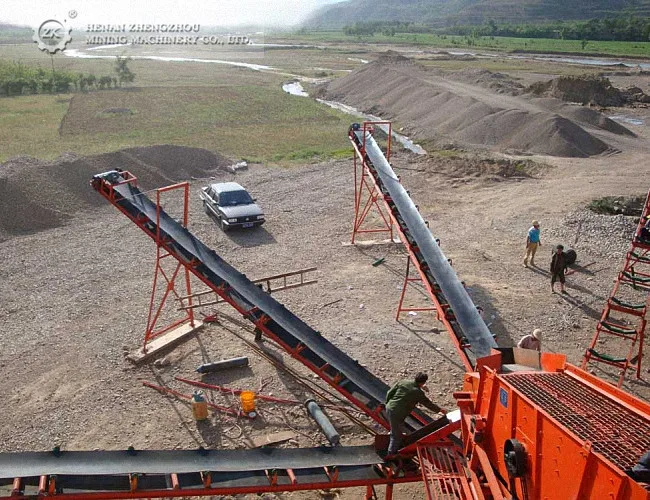The Basic Principles Of Overland Conveyors
Table of ContentsAll About Overland ConveyorsOur Overland Conveyors StatementsNot known Incorrect Statements About Overland Conveyors The 8-Minute Rule for Overland ConveyorsThe Only Guide to Overland Conveyors
Belt Conveyors Belt conveyors are the most common and simplest type of conveyor as well as can have variable rates. They have a moving belt that relaxes on a steel structure that sustains the belt as well as the materials being relocated. Ones that have a sustaining frame beneath are described as gliding design.If a gravity roller conveyor is slanted or installed on an angle, materials relocate by gravity. Items of varying sizes can be loaded on a gravity roller conveyor, employees require to be cautious of larger products running into smaller ones.
Chain Conveyors Chain conveyors can have two or numerous collections of chains that make contact with the base of things to be relocated. The products remainder on the chains as they are moved. Chain driven conveyors are excellent for things with irregular lower surface areas or ones that are extremely hefty.
Because of the kinds of products chain conveyors move, they run really gradually. Motorized Roller Conveyors Motorized roller conveyors use electric motors, placed along the conveyor structure, to power evenly spaced rollers (Overland Conveyors). The design is comparable to a gravity conveyor with the addition of motors. The number of electric motors depends on the load to be moved as well as the overall layout of the system.
What Does Overland Conveyors Do?
In some systems, there is a sensor that begins as well as stops the electric motor to avoid pieces obtaining packed together. Slat Conveyors Slat conveyors have the exact same design as chain conveyors with level slats attached to the chain. Somehow, they resemble belt conveyors with slats changing the belt.
The unit secures the track from wear as well as makes it much easier to put bends and curves in the system. Open Track Conveyors - Open track conveyors do not cover the track and also use I beams as the track. They are simple to install and also ideal for long straight setups. Chain Expenses Conveyors - Chain overhead conveyors make use of a continuous powered chain that runs along a track.
In other layouts where pendants are not made use of, pusher dogs may be used to move carts along a 2nd track positioned under the chain track. This kind of system is referred to as power as well as complimentary. Monorail Conveyors Monorail sharing systems have service providers to relocate products as well as are suitable for use over cross countries.
Monorail conveyors make usage of the area over the production location. In some layouts, the carriers reduced to the degree of manufacturing and after that rise, off the beaten track. Power and Free Conveyors Power as well as complimentary communicating systems are developed to relocate components through the production and also assembly process.
Not known Facts About Overland Conveyors

Inverted Conveyors Inverted conveyors are flooring placed and can be made use of as power and cost-free conveyors. They usually have a drive system that does not include a belt or chain. Paternoster Conveyors Paternoster conveyors are an upright communicating system that utilizes equal spaced load providers attached to a chain drive, which moves in a continual loop.
Chute Conveyors Chute conveyors have a smooth flat surface area constructed from wood, metal, or plastic that is established on an angle in a frame, which can be directly, spiral, or round. Items are glided down the surface - Overland Conveyors. Screw Conveyors Screw conveyors are made use of to relocate bulk materials such as granular items, chips, and loose products.
The chain is qualified of bending along the straight axis enabling it to make horizontal turns as well as can making upright curves. The different sorts of weaves a COE makes enables it to be much more functional than conventional chain driven conveyors. Skid Conveyor Skid conveyors are one more form of floor placed conveyor that relocates products on components that have actually longitudinal joggers called skids with travel being longitudinally and transversely.
The Main Principles Of Overland Conveyors
Skid conveyor systems are valued for the efficiency and also quiet setting of transportation. The variants in skid conveyor systems are due to the several components as well as control systems that can be consisted of. Friction Conveying System A rubbing sharing system uses a motor to drive a friction wheel made from non Visit Website metal material to develop driving pressure.
Rubbing sharing systems are a secure alternative to power and also cost-free systems with the significant benefit of operating cleaner as well as quieter. They have an adaptable format, unit building, easy speed changing, can conveniently be expanded, as well as low overall cost. The main function for rubbing sharing systems is to help with procedures that have a high manufacturing price.

Once the system is in location, its inner operations end up being a facility moving process that is essential to the performance and success of an operation. Exactly How a Conveyor System Works To limit the discussion of sharing systems, the information below concentrates on belt conveying systems considering that they are the most typical.
Support System: The assistance system permits the belt to relocate efficiently. It is especially created to hold more helpful hints the moving material without sagging.
The Main Principles Of Overland Conveyors
In in between them are idler or dummy wheels that are relocated by the belt. The drive wheel presses or draws the load, while the tail wheel returns the belt. As can be seen in the layout, idler pulleys serve a variety of features in directing the belt, which include controlling its tension.